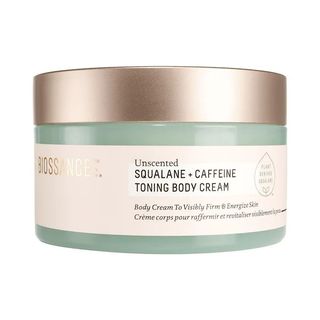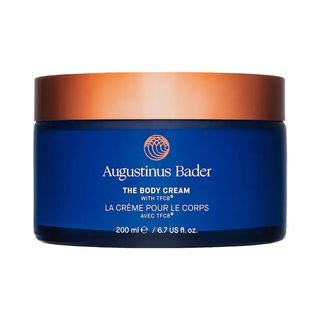How Much Weight Loss Skin Sag
I accept lost 85 pounds without bariatric surgery. Weight loss has been on my heed basically my unabridged life, about peculiarly since I started this journey in earnest in July 2019. And, equally proud of myself as I most certainly am for losing this weight and finally getting healthier, it is met toe-to-toe with pervasive anxiety and a nagging question: What about backlog pare?
Because of the slower footstep at which I'm losing my weight, I haven't still encountered loose skin, though I have at least 50 more pounds left to go. I worry, possibly too much, if I will be able to brand it through to my goal weight without needing skin tightening at the end of this journey.
It's a pretty unsexy topic—which is why information technology's rarely, if ever, discussed. But for those like me who are on major weight loss journeys, or whose bodies accept changed significantly through pregnancy, it's a question that plagues us: Am I going to encounter excess skin the more weight I lose? And if I practise, what can I do about information technology?
Patently, I'one thousand non the simply one with questions, according to New York City plastic surgeon to the stars Lara Devgan. "Skin tightening remains one of the elusive black boxes in the world of plastic surgery," she says. That said, we're all however learning most all-time practices—from me to medical professionals.
And so, I decided to investigate further. Rounding upwardly five renowned dermatologists and plastic surgeons from beyond the land, I ask them all my questions. And here's what they have to say.
If you want to attempt to reduce loose peel from major weight loss, lose the weight slowly.
"Losing weight gradually rather than speedily may preclude backlog skin after major weight loss," Los Angeles–based dermatologist Harold Lancer says. "Withal, rapid big-scale weight loss will invariably result in excess skin." Devgan seconds that. "The best way to foreclose pare laxity afterward weight loss is to do your best to lose weight at a slow and steady pace," she says. "Although information technology may sound appealing to get to the terminate line rapidly, that is actually the worst affair you tin can practise in terms of skin laxity." Slowly losing weight, she says, allows the skin to contract and compress as the shape of the torso shrinks.
If you are having weight loss surgery, consider a surgical one-two dial: weight loss surgery immediately followed by a pare removal surgery.
Though I personally haven't opted for weight loss surgery, many do—and at that place is null shame in that. Just because of the more rapid step with which weight is lost after surgery comes the greater likelihood of excess skin. Why do we accept to worry nearly excess skin, especially afterwards more rapid weight loss? It's "because collagen and elastin fibers are destroyed when skin is stretched significantly and remains stretched for an extended corporeality of time," New York Metropolis plastic surgeon David Shafer says. "Patients should plan on staged procedures if having a weight loss surgery followed by a peel removal surgery."
Peel elasticity is dependent on 2 main factors: age and genetics. But lifestyle choices matter too.
"Typically, younger patients with thicker and more sebaceous skin will accept more skin wrinkle during weight loss due to better elasticity," Devgan says. "Starting in the 20s, tissue elasticity begins to decline. Fifty-fifty in the absence of weight fluctuation, loss of tissue turgor and decreased firmness tin can exist seen in midface descent in the belatedly 20s, chest laxity in the 30s, abdominal laxity in the 40s, and extremity laxity in the 50s."
Nonetheless, anybody'southward trunk is dissimilar, Devgan says. "There is a tremendous corporeality of variability in the human experience, and so some patients may lose fifty pounds with minimal change in their torso, while others can lose as few every bit 10 and see tissue laxity." If yous are genetically blessed with unusually superb tissue elasticity, Devgan says, it can be less dramatic. (And lucky you.)
Also, lifestyle choices can cistron in, likewise, Boston-based dermatologist Ranella Hirsch says. How long were you at the weight you started losing from? Are you a smoker? Do you spend a lot of unprotected time in the sun? All these factors play into pare elasticity.
Keep the skin well hydrated.
"Using an emollient moisturizer rich in vitamin E will help meliorate the barrier protection of the pare and lock in moisture," Devgan says. And the topical medical-course ingredients you use on your face for firmness and tightness of the skin—like hyaluronic acid, peptides, niacin, squalene, vitamins C and B, retinol, and bakuchiol—can work elsewhere, besides, she says. "Most people focus on using these for the confront and cervix in their daily routines, but from a molecular perspective, their efficacy is present anywhere on the body."
Simply save your money on creams that promise you lot the earth.
"Losing large amounts of weight rapidly tends to leave skin behind," Hirsch says. "Though creams with incredible claims abound, they actually do little."
Instead, consider noninvasive treatments and even weight grooming.
Building muscle through weight preparation might help reduce the appearance of lax skin, New York Urban center dermatologist Dendy Engelman says. "This helps reduce the appearance by replacing the lost fat with muscle mass." And at that place are nonsurgical options for dealing with loose skin following weight loss, but they won't help with pare folds or hanging peel.
"Noninvasive treatments such as light amplification by stimulated emission of radiation and radiofrequency can help tighten the skin, but there is a limit to how much they can do," Shafer adds. "Hanging skin more often than not needs to be surgically excised with procedures such every bit abdominoplasty, body lift, and arm lift." There is a difference between loose peel and hanging skin, Shafer says. "It's possible patients tin can manage and treat excess skin cases without undergoing skin removal surgery, such as if the skin is loose but not hanging." He adds, "In that case, noninvasive treatments may exist useful, merely hanging skin virtually often requires surgical excision."
If backlog skin is interfering with your life, then it's time to consider plastic surgery—with the input of multiple medical professionals.
"Afterward major weight loss, people may accept skin that hangs off their body," Engelman says. "These heavy folds can cause wellness problems such as pain, inflammation, and frequent infections from the skin constantly rubbing together. This can happen while exercising or during everyday activities. When a person is having functional issues because of their backlog skin, it should be a sign that this problem needs to be addressed." And, of form, everyone'southward journeying is dissimilar.
Lancer says some individuals will tolerate moderate laxity and be happy with the weight loss accomplishment; others will seek out skin tightening for as fiddling every bit a five-pound weight loss (he is based in L.A. after all). But, he says, if plastic surgery does become the option on the table, "I would recommend getting at least three opinions from doctors who exclusively do excess body pare reduction. Once y'all select a md, do ane pocket-size surface area on your body, so you can evaluate the procedure, how your body heals, and your results. Later on, you can decide whether y'all'd like to proceed with a full-diddled larger process."
He suggests consulting with a dermatologist for nonsurgical options, then having that doctor recommend plastic surgeons who deal with excess trunk skin reduction if y'all feel that is the right path for you lot. It is a major decision that should not be taken lightly. Bring medical professionals along for the entire weight loss journeying (even if you've already started) and enquire all the questions: Which specific process is best? How much will it toll? Will insurance encompass it? (From my research thus far, no if information technology is cosmetic, but perhaps aye if it would help correct something that is limiting the functionality of your daily life.) No question is off-limits, and don't try to brand these decisions alone.
Above all—and perhaps most chiefly—exist proud of yourself.
If this piece applies to you at all, exist it from long-standing weight you carried or from losing weight gained from pregnancy or anywhere in between, that means i thing: You lot've taken major steps toward ameliorate physical health, and that should be applauded. "Everyone's weight loss story is different, and some days are harder than others," Engelman says. "I say, try to be kind to yourself. Y'all've but reached a huge accomplishment and should be proud of that."
Devgan agrees. "Accomplishing a personal health goal like major weight loss is an incredible achievement that anyone should be proud of," she says. "While excess skin can feel like a burden or source of self-consciousness, it is also a reminder of the metaphorical and literal shedding of the weight of a prior version of oneself. Y'all cannot accept a couture gown without a seam, and you cannot have a surgery without a scar. Life has limitations, simply that does not get in less cute. It makes information technology more real."
This content is created and maintained by a 3rd party, and imported onto this folio to assistance users provide their email addresses. Y'all may be able to find more information about this and like content at piano.io
Source: https://www.harpersbazaar.com/beauty/health/a38973337/weight-loss-excess-loose-skin-tightening-surgery-explained/
Posted by: swartzblan1947.blogspot.com





0 Response to "How Much Weight Loss Skin Sag"
Post a Comment